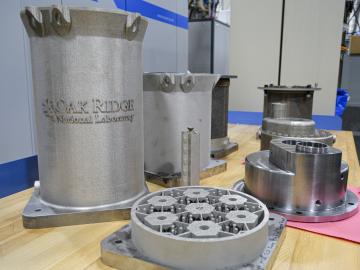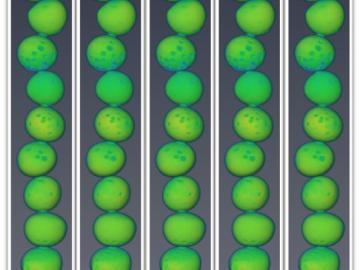
Filter News
Area of Research
- (-) Nuclear Science and Technology (13)
- (-) Supercomputing (11)
- Advanced Manufacturing (2)
- Biology and Environment (2)
- Computer Science (2)
- Energy Science (15)
- Fuel Cycle Science and Technology (1)
- Fusion and Fission (1)
- Fusion Energy (3)
- Isotope Development and Production (1)
- Isotopes (1)
- Materials (34)
- Materials for Computing (2)
- National Security (4)
- Neutron Science (11)
- Nuclear Systems Modeling, Simulation and Validation (2)
- Sensors and Controls (1)
News Type
News Topics
- (-) Advanced Reactors (4)
- (-) Artificial Intelligence (3)
- (-) Grid (1)
- (-) Isotopes (4)
- (-) Materials Science (5)
- (-) Nuclear Energy (11)
- (-) Physics (2)
- (-) Polymers (2)
- (-) Space Exploration (2)
- 3-D Printing/Advanced Manufacturing (3)
- Big Data (2)
- Bioenergy (3)
- Biology (1)
- Biomedical (7)
- Chemical Sciences (1)
- Computer Science (17)
- Coronavirus (4)
- Critical Materials (1)
- Energy Storage (1)
- Environment (4)
- Frontier (1)
- Fusion (2)
- High-Performance Computing (1)
- Machine Learning (2)
- Materials (2)
- Microscopy (2)
- Molten Salt (4)
- Nanotechnology (3)
- National Security (1)
- Neutron Science (7)
- Quantum Science (4)
- Summit (10)
- Transportation (2)
Media Contacts

Researchers at the Department of Energy’s Oak Ridge National Laboratory are refining their design of a 3D-printed nuclear reactor core, scaling up the additive manufacturing process necessary to build it, and developing methods

In the 1960s, Oak Ridge National Laboratory's four-year Molten Salt Reactor Experiment tested the viability of liquid fuel reactors for commercial power generation. Results from that historic experiment recently became the basis for the first-ever molten salt reactor benchmark.

Oak Ridge National Laboratory researchers working on neutron imaging capabilities for nuclear materials have developed a process for seeing the inside of uranium particles – without cutting them open.

OAK RIDGE, Tenn., Feb. 19, 2020 — The U.S. Department of Energy’s Oak Ridge National Laboratory and the Tennessee Valley Authority have signed a memorandum of understanding to evaluate a new generation of flexible, cost-effective advanced nuclear reactors.

An international team of researchers has discovered the hydrogen atoms in a metal hydride material are much more tightly spaced than had been predicted for decades — a feature that could possibly facilitate superconductivity at or near room temperature and pressure.

The Department of Energy’s Oak Ridge National Laboratory is collaborating with industry on six new projects focused on advancing commercial nuclear energy technologies that offer potential improvements to current nuclear reactors and move new reactor designs closer to deployment.

Scientists from Oak Ridge National Laboratory performed a corrosion test in a neutron radiation field to support the continued development of molten salt reactors.

The United Kingdom’s National Nuclear Laboratory and the U.S. Department of Energy’s Oak Ridge National Laboratory have agreed to cooperate on a wide range of nuclear energy research and development efforts that leverage both organizations’ unique expertise and capabilities.

The Department of Energy’s Oak Ridge National Laboratory is now producing actinium-227 (Ac-227) to meet projected demand for a highly effective cancer drug through a 10-year contract between the U.S. DOE Isotope Program and Bayer.

Scientists at the Department of Energy’s Oak Ridge National Laboratory are the first to successfully simulate an atomic nucleus using a quantum computer. The results, published in Physical Review Letters, demonstrate the ability of quantum systems to compute nuclear ph...


